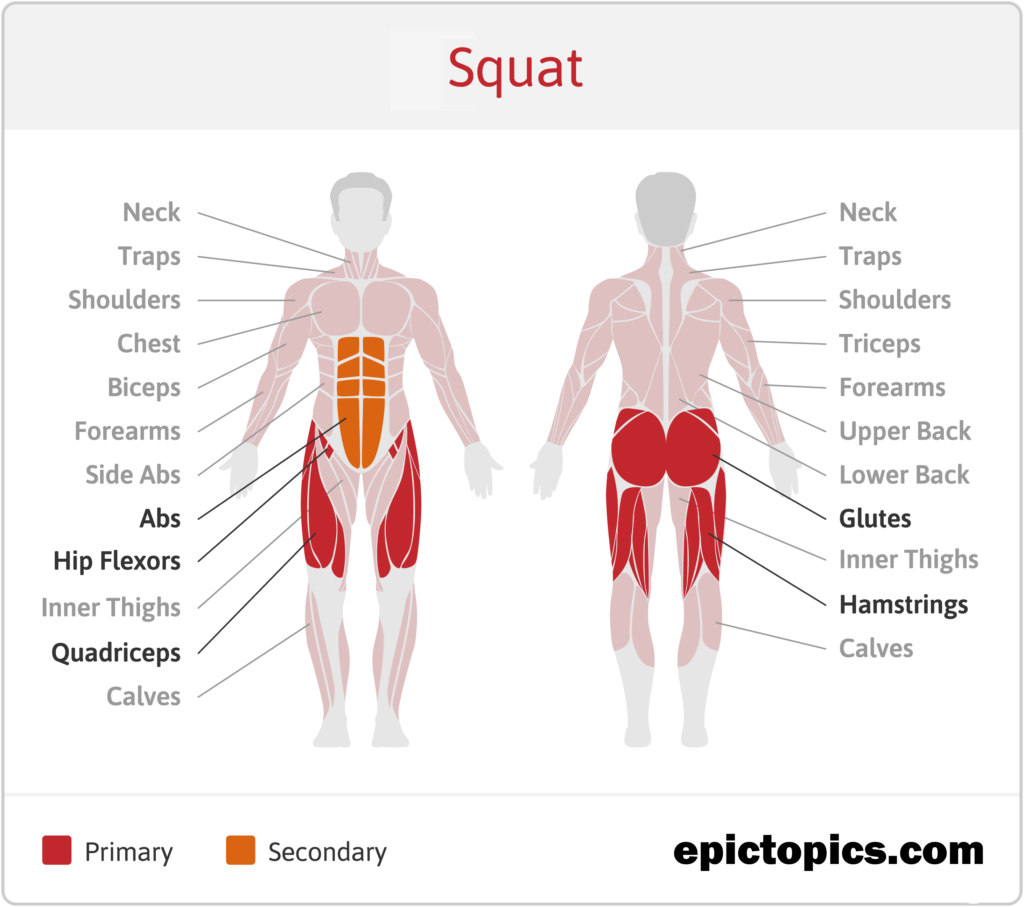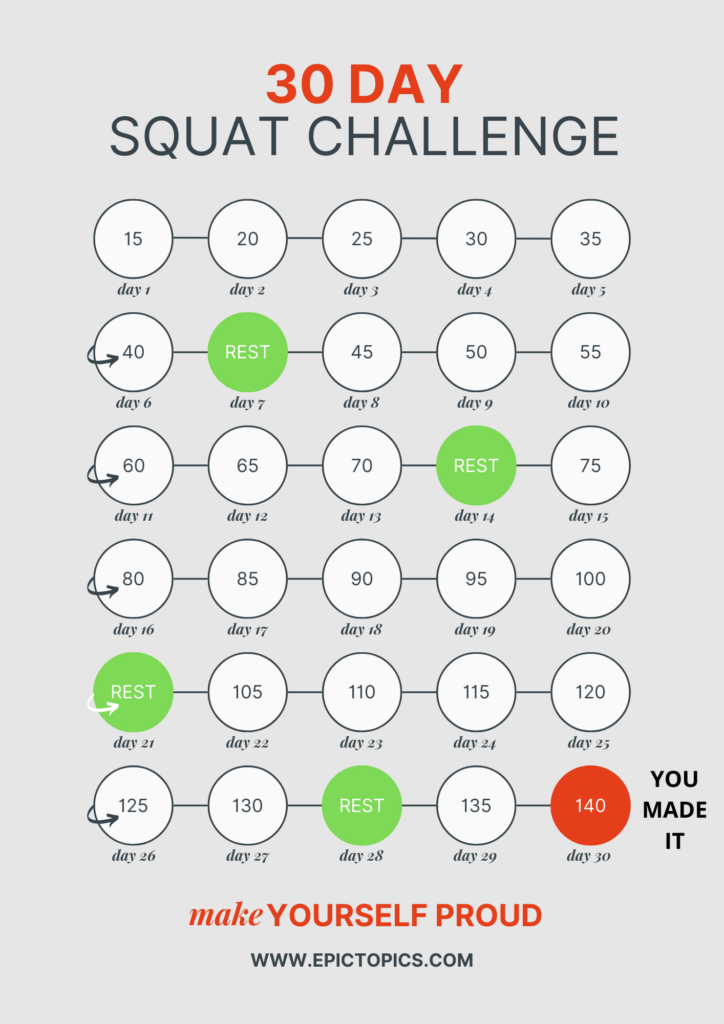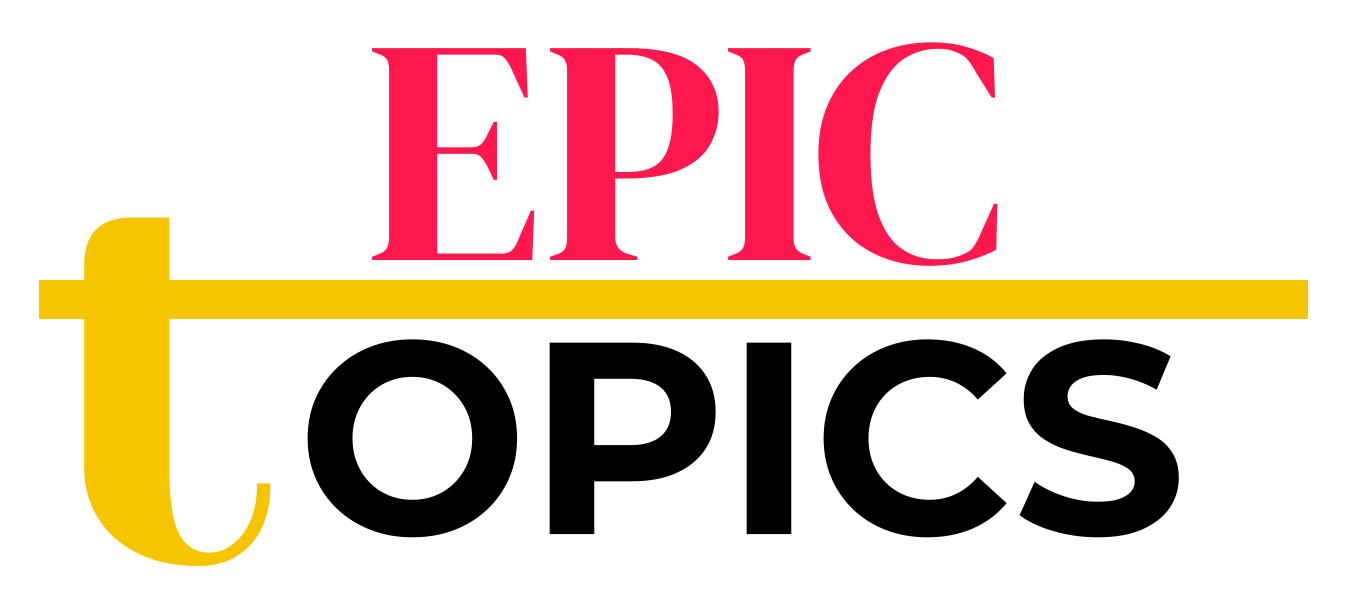Squats are one of the most fundamental exercises in fitness, widely recognized for their ability to build strength, tone muscles, and improve overall health. This guide will walk you through everything you need to know about squat exercises, including proper technique, benefits, common mistakes, and how many calories you can burn by doing squats. If you want to achieve strong legs and a powerful core, understanding how to do the squat exercise correctly is essential.
What Is a Squat Exercise?
Firstly a squat is a functional, full-body exercise that primarily targets the muscles of the lower body, including the quadriceps, hamstrings, glutes, and calves. When done correctly, squats also engage the core and lower back muscles, helping improve stability and posture. The squat exercise is versatile and can be performed with just your body weight or added resistance, such as dumbbells or a barbell.
Squat Targeted Muscles

| Primary Muscles | Secondary Muscles |
| Quads | Abs |
| Hip Flexors | |
| Hamstrings | |
| Glutes |
Why You Should Do Squats
Squats offer numerous benefits, from building muscle and burning fat to enhancing overall mobility. Here’s why adding squats to your routine can be a game-changer:
- Builds Lower Body Strength: Squats target major muscle groups like the thighs, glutes, and calves, helping build strength and muscle definition.
- Improves Core Stability: When performing squats, your core muscles work to stabilize the body, leading to a stronger midsection.
- Increases Flexibility: Squats help improve the range of motion in your hips, knees, and ankles, leading to better mobility.
- Burns Calories: Because squats engage multiple muscles, they can help you burn calories and lose weight.
- Enhances Athletic Performance: Strong legs are crucial for activities like running, jumping, and lifting. Squats can help you perform better in various sports.
How to Do Squat Exercise Properly

The key to getting the most out of squats is performing them with the correct technique. Follow these steps to execute the perfect squat:
- Stand with your feet shoulder-width apart: Your toes should be slightly pointed out, allowing your knees to track in line with your feet.
- Engage your core: Tighten your abdominal muscles to help stabilize your spine throughout the movement.
- Lower your body: Bend your knees and hips to lower yourself as if you’re sitting back in a chair. Keep your chest up and avoid rounding your back.
- Go as low as comfortable: Aim to get your thighs parallel to the floor. If you have good flexibility, you can go lower, but ensure your knees don’t go past your toes.
- Drive through your heels: Push back up to the starting position by pressing through your heels, engaging your glutes and thighs as you rise.
- Repeat for the desired number of reps: Maintain proper form throughout each repetition to avoid injury.
Common Mistakes to Avoid When Doing Squats
To maximize the benefits of the squat exercise, it’s important to avoid these common mistakes:
- Allowing the knees to cave in: Make sure your knees stay in line with your toes as you squat down.
- Rounding the back: Keep your chest lifted and your back straight to prevent injury.
- Not going low enough: For the squat to be effective, your thighs should be at least parallel to the ground.
- Lifting the heels off the ground: Keep your heels firmly planted on the floor throughout the movement.
- Rushing the movement: Perform the exercise in a controlled manner, with proper form, to engage the right muscles.
How Many Calories Does Squat Exercise Burn?
Squats are not just effective for building muscle; they are also great for burning calories. The number of calories burned depends on various factors, including your weight, intensity, and the number of sets you perform. Here’s a simple estimate of how many calories are burned by doing squats:
| Number of Squats | Calories Burned (average for a 155-pound person) |
| 10 Squats | 2-4 Calories |
| 20 Squats | 4-8 Calories |
| 30 Squats | 6-12 Calories |
These numbers are just estimates, and actual calories burned can vary depending on factors such as body weight, squat depth, and speed.
Calculate your Calories
30-Day Squats Challenge

Squat Variations to Try
The basic squat is an excellent starting point, but there are many variations you can try to target different muscles or increase the difficulty:
- Goblet Squat: Hold a dumbbell or kettlebell close to your chest to add resistance and challenge your core.
- Jump Squat: Perform a basic squat, then explode upward into a jump. This variation adds a cardio element and works your calves.
- Sumo Squat: Stand with your feet wider than shoulder-width apart, toes pointed outward. This targets the inner thighs and glutes more effectively.
- Bulgarian Split Squat: Place one foot behind you on a bench or chair and squat down with the front leg. This one-sided variation challenges balance and works the legs intensely.
- Barbell Back Squat: Place a barbell across your shoulders for a more advanced squat variation that allows for greater weight, building strength quickly.
Tips for Beginners
If you’re new to squats, start with bodyweight squats to practice the proper form before adding weights. You can use a chair or box to squat down onto if you’re unsure of your depth. Performing squats in front of a mirror can also help you monitor your form.
As you progress, try incorporating different squat variations to keep your workouts engaging and challenging. Aim to perform squats at least two to three times a week as part of a balanced workout routine.
Benefits of Adding Weights to Squat Exercise
Adding weights to your squat exercise can significantly increase its effectiveness. Weighted squats require more muscle activation and can help you build strength faster. Here’s why you might consider adding resistance:
- Increases muscle growth: Heavier weights provide a stronger stimulus for muscle growth.
- Improves bone density: Lifting weights strengthens bones as well as muscles.
- Boosts metabolism: More muscle mass leads to a higher metabolism, helping you burn more calories even at rest.
Start with light weights, such as a pair of dumbbells, and gradually increase the weight as you become more comfortable with the movement.
Incorporating Squats into Your Fitness Routine
Squats are a versatile exercise that can be added to various workout programs. Here are some ways to incorporate squats into your routine:
- Strength Training: Include weighted squats in your leg day routine for lower body strength.
- HIIT Workouts: Use jump squats as part of a high-intensity interval training session to maximize fat burn.
- Cardio Warm-up: Add bodyweight squats before your cardio session to warm up your legs and get your heart rate up.
Conclusion
Understanding how to do squat exercises correctly is key to reaping its benefits. Squats are a functional movement that strengthens the lower body, tones the core, and burns calories. Whether you’re a beginner or an advanced athlete, squats can be modified to match your fitness level. Start slow, focus on your form, and gradually increase intensity to challenge yourself.
Adding squats to your fitness routine can bring you closer to achieving a toned, strong, and healthy body. So don’t hesitate—start squatting today, and enjoy the numerous benefits that come with this powerful exercise.
Follow us on Pinterest











